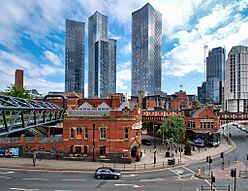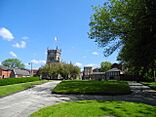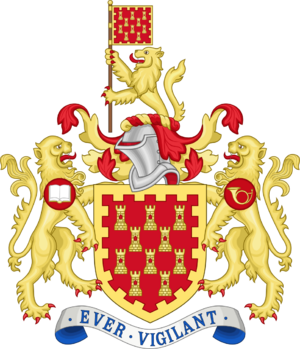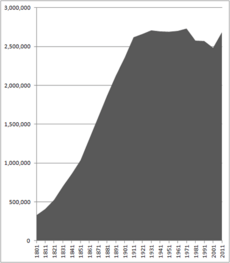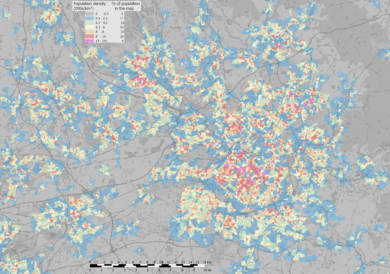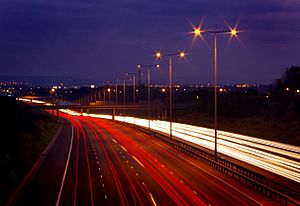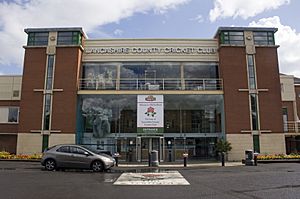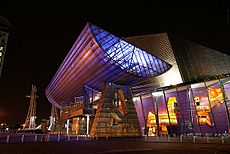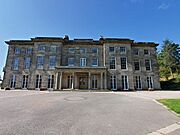Greater Manchester facts for kids
Quick facts for kids
Greater Manchester
|
|||||||||||||||||||||||||||||||||||||||
|---|---|---|---|---|---|---|---|---|---|---|---|---|---|---|---|---|---|---|---|---|---|---|---|---|---|---|---|---|---|---|---|---|---|---|---|---|---|---|---|
|
|
|||||||||||||||||||||||||||||||||||||||
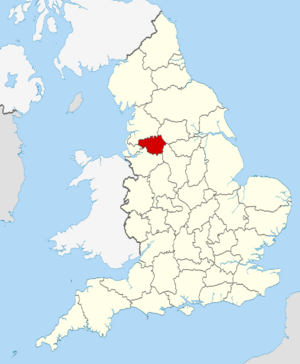
Location of Greater Manchester within England
|
|||||||||||||||||||||||||||||||||||||||
| Sovereign state | United Kingdom | ||||||||||||||||||||||||||||||||||||||
| Constituent country | England | ||||||||||||||||||||||||||||||||||||||
| Region | North West England | ||||||||||||||||||||||||||||||||||||||
| Established | 1 April 1974 | ||||||||||||||||||||||||||||||||||||||
| Established by | Local Government Act 1972 | ||||||||||||||||||||||||||||||||||||||
| Time zone | UTC±00:00 (Greenwich Mean Time) | ||||||||||||||||||||||||||||||||||||||
| • Summer (DST) | UTC+01:00 (British Summer Time) | ||||||||||||||||||||||||||||||||||||||
| Members of Parliament | 27 MPs | ||||||||||||||||||||||||||||||||||||||
| Police | Greater Manchester Police | ||||||||||||||||||||||||||||||||||||||
|
|||||||||||||||||||||||||||||||||||||||
Greater Manchester is a large area in North West England. It is a ceremonial county, which means it has a special status for official events. The county shares borders with Lancashire to the north, Derbyshire and West Yorkshire to the east, Cheshire to the south, and Merseyside to the west. The biggest city in Greater Manchester is Manchester.
This county covers about 493 square miles (1,277 km2) and has many towns and cities. Around 2.8 million people live here, making it a very busy place. Most of the towns in Greater Manchester are part of the Greater Manchester Built-up Area. This area is the second most populated urban area in the UK. Besides Manchester, other big towns include Bolton, Rochdale, Sale, Salford, Stockport and Wigan.
Greater Manchester has ten main areas called metropolitan boroughs. These are Manchester, Salford, Bolton, Bury, Oldham, Rochdale, Stockport, Tameside, Trafford and Wigan. The councils for these areas work together through the Greater Manchester Combined Authority. Greater Manchester was officially created on 1 April 1974. It was formed from parts of older counties like Cheshire, Lancashire, and Yorkshire.
The middle and southwest parts of Greater Manchester are mostly flat. But the north and east areas are part of the Pennines, which are hills and mountains. Many of the county's rivers start in the Pennines. These rivers, like the Mersey and Irwell, flow through the area. The Manchester Ship Canal connects the county to the sea.
Before the Industrial Revolution, Greater Manchester was mostly countryside. But then, factories and industries grew very quickly. The towns became important for making cotton textiles. This was helped by the local coalfields. The area also became a hub for engineering and science. For example, the first inter-city railway was built here. After industries declined in the mid-20th century, Greater Manchester became a major centre for services, media, and digital jobs. It is also famous for its music scene and football teams.
Contents
- History of Greater Manchester
- Geography of Greater Manchester
- Historic County Borders
- How Greater Manchester is Governed
- People and Population of Greater Manchester
- Education in Greater Manchester
- Economy of Greater Manchester
- Transport in Greater Manchester
- Sport in Greater Manchester
- Culture in Greater Manchester
- Places to Visit in Greater Manchester
- See also
History of Greater Manchester
Early Settlements and Roman Times
Even though Greater Manchester was created in 1974, its towns have a very long history. There is proof that people lived here during the Iron Age. For example, at Mellor, and a known Celtic settlement called Chochion, which was likely in Wigan. Stretford was also home to the Celtic Brigantes tribe. The Romans also lived here. You can still see remains of 1st-century forts at Castlefield in Manchester and Castleshaw Roman Fort in Saddleworth.
Ancient Divisions of the Land
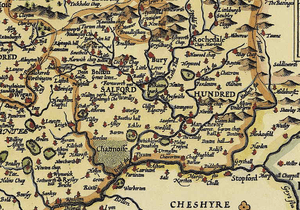
In 1086, the area from the River Mersey to the River Ribble was surveyed as part of Cheshire. Later, from the creation of Lancashire up to the 1700s, a part of Lancashire called Salfordshire covered a similar but smaller area to today's county. Other parts of what is now Greater Manchester, south of the Mersey and Tame, were part of Cheshire. The Saddleworth area and a small part of Mossley were historically part of Yorkshire.
The Rise of Manchesterthum
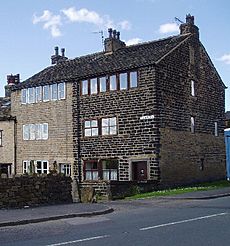
In the late 1700s and early 1800s, the Industrial Revolution completely changed the area. New machines allowed factories to produce textiles (cloth) on a huge scale. This led to a rapid growth in the cotton industry. The area became very important for England's wool trade. German traders even called the region around Manchester "Manchesterthum".
Many new houses, factories, and roads were built to support the growing population and transport goods. Towns around Manchester grew incredibly fast. Places like Bury, Oldham, and Bolton became major cotton-producing towns. By the late 1800s, they were some of the most important in the world. Manchester itself was the biggest city and the world's largest marketplace for cotton goods. By 1848, the city had grown so much that it merged with its surrounding towns, forming one continuous urban area.
Creating Greater Manchester in 1974
Before 1974, the area that is now Greater Manchester was split between parts of Cheshire, Lancashire, and Yorkshire. This old system was not working well for modern times. The Local Government Act 1972 changed how local government worked in England. On 1 April 1974, Greater Manchester was officially created as a new type of county called a metropolitan county.
This new system had two levels of government: the Greater Manchester County Council (GMCC) and the ten local borough councils. The GMCC was in charge of big things like transport, planning, and emergency services for the whole county. The name "Greater Manchester" was chosen after people were asked what they preferred. It was seen as a way to bring together a region that already had strong connections through history.
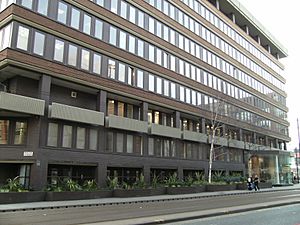
The GMCC worked to improve the quality of life for people. It focused on making the environment better and improving cultural places. It also worked to bring people back to central Greater Manchester and improve transport. For example, it created the Greater Manchester Exhibition Centre (now Manchester Central) for cultural events. It also made five new country parks.
However, the Greater Manchester County Council was abolished on 31 March 1986. This was part of a government decision to remove all metropolitan county councils. Many of its jobs were given to the ten local borough councils. Services like emergency services and public transport continued to be run for the whole county by special joint boards. The Association of Greater Manchester Authorities (AGMA) was set up to help the boroughs work together. Greater Manchester still exists as a ceremonial county today.
The Combined Authority and Mayor
In recent years, there have been efforts to bring the local councils in Greater Manchester closer together again. In 2011, the Greater Manchester Combined Authority (GMCA) was created. This new body helps the ten councils work together on important issues. These include public transport, housing, waste management, and planning.
In 2017, the first directly elected Mayor of Greater Manchester was chosen. This mayor, currently Andy Burnham, leads the GMCA. The mayor has special powers over transport, housing, planning, and policing. This helps to make decisions for the whole region more easily.
Geography of Greater Manchester
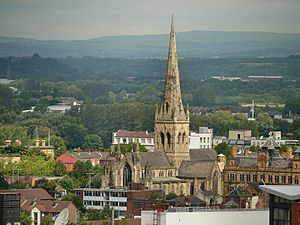
Greater Manchester is a county without a coastline, covering about 493 square miles (1,277 km2). The Pennines hills are to the north and east, including the West Pennine Moors and the Peak District. In the west, there are coalfields. The Cheshire Plain is to the south. Rivers like the Mersey, Irwell, and Tame flow through the county. They all start in the Pennines. The highest point in Greater Manchester is Black Chew Head, which is 1,778 feet (542 metres) above sea level. It is part of the Peak District National Park.
Greater Manchester has many busy urban and industrial areas. These include places for shopping, business, and offices. There are also many suburbs and homes. The area has a mix of very busy city parts, quieter suburbs, and even some rural countryside. Buildings often use red brick and sandstone. You can also see modern high-rise buildings in the city and town centres.

Manchester city centre is the main business and geographic heart of Greater Manchester. It is called the "Regional Centre" for planning and transport. Manchester, along with parts of Salford and Trafford, forms a central business area with tall buildings. However, Greater Manchester is also "polycentric," meaning it has ten main districts. Each district has its own important town centre. These major towns surround Manchester city centre. Other smaller towns are suburbs to both Manchester and these larger town centres. This makes Greater Manchester a very complex urban area.
The Greater Manchester Built-up Area is the continuous urban area around Greater Manchester. In 2011, it had over 2.5 million people. This makes it the second most populated urban area in the UK. This built-up area includes most of Greater Manchester's towns and cities. It also extends into nearby counties like Cheshire and Derbyshire.
Climate in Greater Manchester
Greater Manchester has a mild, wet climate, like most of the UK. Summers are usually cool, and winters are mild. The county gets about 806.6 mm (31.76 inches) of rain each year. This is less than the UK average. It rains about 140 days a year. Temperatures are slightly above the UK average. The area has high humidity, which was good for textile manufacturing in the past. Snow is not common in the cities because of the "urban warming" effect. However, the hills like the West Pennine Moors and Peak District get more snow. Roads leading out of the county can sometimes close due to heavy snowfall.
Plants and Animals of Greater Manchester

Even though Greater Manchester is very urban, it has a lot of wildlife and natural places. There are wooded valleys, moorlands, and wetlands. These areas are home to important plants and animals. Habitats include woodlands, grasslands, farmlands, lakes, and urban parks. The Greater Manchester Ecology Unit helps to protect these important natural sites.
There are 21 special areas called Sites of Special Scientific Interest (SSSI) in Greater Manchester. These are very important for wildlife. For example, Astley and Bedford Mosses are old peat bogs. The Wigan Flashes are lakes formed from old coal mining areas. These lakes are important for reed beds. Sale Water Park is a large park with a lake by the River Mersey.
Common plants like clover, sorrel, nettle, and thistle grow wild. Common heather covers the uplands like Saddleworth Moor. The Rochdale Canal is home to a rare aquatic plant called floating water-plantain. In 2002, Common cottongrass was chosen as the county flower of Greater Manchester.
Many birds live in Greater Manchester, including the house sparrow, starling, and blackbird. You can also see magpies and pigeons. In south Manchester parks, you might spot flocks of feral parakeets. These birds are not native but have made the UK their home. The South Pennines are important for birds like golden plover and curlew. Small turtles called Red Eared Terrapins live in the lake at Alexandra Park.
Historic County Borders

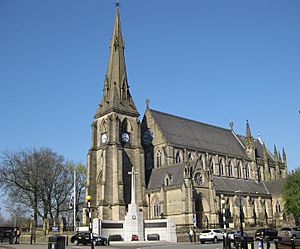
Greater Manchester is made up of parts of three historic counties: Cheshire, Lancashire, and West Riding of Yorkshire. The old border between Cheshire and Lancashire follows the River Irwell and the Manchester Ship Canal. Southern parts of the county, like Altrincham, Sale, Stockport, and Hyde, were historically part of Cheshire.
Most of the county north of the River Irwell, including Manchester, Salford, Bolton, Bury, Wigan, and Rochdale, was part of historic Lancashire. The eastern and northeastern parts, like Saddleworth and some areas of Rochdale, were historically part of West Riding of Yorkshire.
Local Identity and Calls for Change
Since Greater Manchester was formed, some people have debated their local identity. They feel more connected to their historic counties. For example, residents in Saddleworth have asked to be separate from Greater Manchester and Oldham Council. They want to rejoin Yorkshire. In 2015, a petition asked for Wigan to rejoin Lancashire. This shows that local heritage and location are important to people.
How Greater Manchester is Governed
The Greater Manchester Combined Authority (GMCA) is the main body that governs Greater Manchester. It was set up in 2011 to help the ten local councils work together. The GMCA has powers over public transport, skills, housing, and waste management. It also handles big decisions about planning.

Since 2017, the GMCA has been led by a directly elected Mayor of Greater Manchester. The mayor has extra powers over transport, housing, and policing. This helps to make sure decisions are made for the whole region.
Below the GMCA are the ten local councils of Greater Manchester's districts. These are Bolton, Bury, Manchester, Oldham, Rochdale, Salford, Stockport, Tameside, Trafford, and Wigan. These councils have the most power over local services. They manage things like council tax, schools, libraries, and local healthcare. Most of these boroughs are named after their largest town. For example, the Metropolitan Borough of Stockport is centred on the town of Stockport. Some boroughs, like Tameside and Trafford, have neutral names.
For the first 12 years (1974-1986), Greater Manchester had a two-tier government system. The Greater Manchester County Council (GMCC) shared power with the local borough councils. The GMCC handled regional services like transport and emergency services. In 1986, the GMCC was abolished. Most of its powers went to the local boroughs.
After 1986, the ten local councils worked together voluntarily. They formed the Association of Greater Manchester Authorities (AGMA). This helped them coordinate on issues like public transport. Now, under the GMCA, joint boards manage key services. These include Transport for Greater Manchester (TfGM), the Greater Manchester Fire and Rescue Service, and the Greater Manchester Waste Disposal Authority. Greater Manchester Police is now overseen by the regional mayor. The ten borough councils also jointly own the Manchester Airport Group.
Greater Manchester is also a ceremonial county. This means it has a Lord-Lieutenant who represents the monarch. The county is used by the government to collect statistics and census information.
In the Parliament of the United Kingdom, Greater Manchester is divided into 27 areas called parliamentary constituencies. Most of these areas are represented by the Labour Party.
People and Population of Greater Manchester

| Population changes for Greater Manchester | ||||||||||||||||||||||||||||||||||||||||||||||||||||||||||||||||||||||||||||
|---|---|---|---|---|---|---|---|---|---|---|---|---|---|---|---|---|---|---|---|---|---|---|---|---|---|---|---|---|---|---|---|---|---|---|---|---|---|---|---|---|---|---|---|---|---|---|---|---|---|---|---|---|---|---|---|---|---|---|---|---|---|---|---|---|---|---|---|---|---|---|---|---|---|---|---|---|
|
|
|||||||||||||||||||||||||||||||||||||||||||||||||||||||||||||||||||||||||||
| Pre-1974 statistics were gathered from local government areas that now comprise Greater Manchester Source: Great Britain Historical GIS. |
||||||||||||||||||||||||||||||||||||||||||||||||||||||||||||||||||||||||||||
| District | Land area | Population | Density (/km2) |
||
|---|---|---|---|---|---|
| (km2) | (%) | People | (%) | ||
| Bolton | 139.8 | 11% | 287,550 | 10% | |
| Bury | 99.49 | 8% | 190,990 | 7% | |
| Manchester | 115.6 | 9% | 552,858 | 19% | |
| Oldham | 142.3 | 11% | 237,110 | 8% | |
| Rochdale | 158.1 | 12% | 222,412 | 8% | |
| Salford | 97.19 | 8% | 258,834 | 9% | |
| Stockport | 126.1 | 10% | 293,423 | 10% | |
| Tameside | 103.2 | 8% | 226,493 | 8% | |
| Trafford | 106.0 | 8% | 237,354 | 8% | |
| Wigan | 188.2 | 15% | 328,662 | 12% | |
| Greater Manchester | 1,276 | 100% | 2,835,686 | 100% | [convert: invalid number] |
Greater Manchester has a population of 2,867,800 people (2021 Census). This makes it the third most populated county in England. People from Greater Manchester are sometimes called "Greater Mancunians." The Manchester accent is common in the city and nearby areas.
Greater Manchester is home to many different cultures and ethnic groups. In 2001, about 8.5% of the population belonged to ethnic minority groups. In 2008, there were over 66 different refugee nationalities in the county. In terms of religion (2001 census), most residents were Christian (74.2%). There were also significant numbers of Muslims (5.0%) and Jewish people (0.9%).
After industries declined in the mid-20th century, the population in Greater Manchester dropped, especially in Manchester and Salford. Many old terraced houses from the Victorian era were in poor condition. This led to slum clearance and the building of new social housing. During the 1970s, 80s, and 90s, the population decreased by over 8,000 people each year.
Greater Manchester has many types of housing. Manchester city centre has many high-rise apartments. Salford has some of Europe's tallest apartment blocks. In contrast, Saddleworth has stone-built homes like farmhouses. Terraced houses, built in the Victorian and Edwardian periods, are common throughout the county. House prices and job markets vary across Greater Manchester. Southern areas like Bramhall, Woodford, and Altrincham are known for their wealthier commuter towns.
Education in Greater Manchester
Greater Manchester has six universities. These are the Manchester Metropolitan University, the University of Bolton, the University of Law, the University of Manchester, the University of Salford, and The University Campus of Football Business. Along with the Royal Northern College of Music, these universities had over 101,000 students in 2007. This is the third highest number of students in England. Many students are located on Oxford Road in Manchester, which is Europe's largest area for higher education.
For further education, there is the Greater Manchester Colleges Group. This group includes 24 colleges in the region. Primary and secondary education is managed by the local borough councils. The county also has several independent schools, such as Bolton School and Manchester Grammar School.
Economy of Greater Manchester
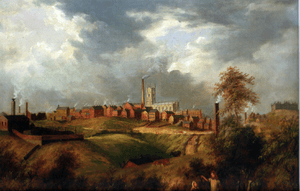
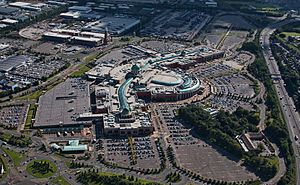
| District | GVA (£ billions) | GVA per capita (£) | GDP (£ billions) | GDP per capita (£) |
|---|---|---|---|---|
| Bolton | £6.3 | £21,406 | £7.3 | £24,657 |
| Bury | £3.6 | £18,403 | £4.2 | £21,472 |
| Manchester | £26.5 | £48,107 | £28.2 | £51,330 |
| Oldham | £4.0 | £16,652 | £4.7 | £19,578 |
| Rochdale | £3.9 | £17,181 | £4.5 | £20,247 |
| Salford | £8.7 | £32,246 | £9.6 | £35,529 |
| Stockport | £7.2 | £24,370 | £8.1 | £27,425 |
| Tameside | £3.5 | £14,991 | £4.1 | £17,890 |
| Trafford | £9.6 | £40,769 | £10.4 | £44,192 |
| Wigan | £5.5 | £16,712 | £6.5 | £19,649 |
| Greater Manchester | £78.7 | £27,452 | £87.7 | £30,576 |
Much of Greater Manchester's wealth came from the Industrial Revolution. The area was famous for making textiles, especially cotton. The world's first cotton mill was built in Royton. Many towns in the county grew around these mills. Greater Manchester was a key area for textile manufacturing until the early 20th century.
However, these traditional industries declined over time. This was partly due to the Lancashire Cotton famine and later the post-war economic depression. The region has since changed its economy. For example, the docks at Salford Quays were once an industrial port. Now, they are a modern area with shops, homes, and attractions like the Imperial War Museum North. The BBC also moved many of its departments to MediaCityUK at Salford Quays.
Today, Greater Manchester is the economic heart of the North West region. It is the largest regional economy in the UK outside London. Greater Manchester's economy is worth over £82.7 billion. Manchester city centre is a major hub for trade and business. It helps give Greater Manchester a global identity. Manchester is now a centre for arts, media, education, and business. In 2006, business leaders thought Manchester was the best place in the UK to start a business. It is also the third most visited city in the UK by foreign tourists.
In 2001, most people aged 16 to 74 in Greater Manchester were employed (40.3% full-time, 11.3% part-time). The main industries were retail, manufacturing, and business services. The number of jobs in agriculture is very low because the county is mostly urban.
Transport in Greater Manchester

Public transport in Greater Manchester is managed by Transport for Greater Manchester (TfGM). This public body was set up in 1969. It plans and coordinates public transport across the county. TfGM has more powers than a regular transport executive.
Greater Manchester is a key part of the North West transport network. Many roads meet in Manchester city centre. The county is the only place in the UK with a full orbital motorway, the M60. This motorway goes through almost all the boroughs. Greater Manchester has more motorway per square mile than any other county. The A580 "East Lancs" road connects Manchester and Salford to Liverpool. It was the UK's first purpose-built intercity highway, opened in 1934.
The Metrolink is Greater Manchester's light rail system. It started in 1992 and is mainly used for commuting. As of December 2020, the network is 57 miles (92 km) long. It has eight lines that spread out from Manchester city centre. These lines go to places like Altrincham, Ashton-under-Lyne, Bury, Manchester Airport, and the Trafford Centre. TfGM owns the system.
Greater Manchester also has a large heavy rail network with 98 stations. Train services are run by private companies on the national rail network. There is also a wide bus network, with services radiating from Manchester city centre. Major bus companies include Diamond Bus North West, First Greater Manchester, and Stagecoach Manchester. An extensive canal network from the Industrial Revolution is still in use.
Manchester Airport is the third busiest airport in the UK. It offers flights to more worldwide destinations than any other UK airport. In 2008, it handled over 21 million passengers.
Public transport is very popular in the area. In 2005/2006, there were 19.7 million rail journeys and 19.9 million Metrolink journeys. The bus system carried 219.4 million passengers.
The Bee Network is a new integrated transport network for Greater Manchester. It includes bus, tram, cycling, and walking routes. TfGM plans to have the full network working by 2024. Commuter rail services will join by 2030. The goal is to create a London-style transport system. This will encourage more people to use public transport instead of cars. The network's design is inspired by the worker bee, a symbol of Greater Manchester. Buses and trams are yellow and black.
Greater Manchester is investing more money in walking, wheeling, and cycling paths. This will create the largest active travel network in the country.
Sport in Greater Manchester

Manchester hosted the 2002 Commonwealth Games. This was a very big and expensive sporting event for the UK at the time. It cost £200 million for sports facilities and £470 million for local infrastructure. The games helped to improve the city. New facilities included the Manchester Aquatics Centre and the City of Manchester Stadium. After the games, the City of Manchester Stadium was changed for football use.
Association football is a huge part of Greater Manchester's culture. The county has many football clubs, with two playing in the top league, the Premier League. These clubs bring many fans and visitors to Greater Manchester. This adds £330 million to the economy each year. The Manchester Football Association helps promote and develop the sport.
Manchester United F.C. is one of the world's most famous football teams. They have won the League Championship a record twenty times. They have also won the FA Cup twelve times and the European Champions League three times. Their home ground, Old Trafford, has hosted major matches. Manchester City F.C. moved to the City of Manchester Stadium after the Commonwealth Games. They have won the league championship nine times and the FA Cup seven times. Wigan Athletic F.C. won their first major trophy in 2013, beating Manchester City in the FA Cup final. Other local teams include Bolton Wanderers F.C., Salford City F.C., Stockport County F.C., Oldham Athletic A.F.C., Rochdale A.F.C., and Altrincham F.C..
In rugby league, Wigan Warriors, Leigh Leopards, and Salford Red Devils play in the Super League. Wigan Warriors have won many titles. Other rugby league teams include Swinton Lions and Oldham R.L.F.C.. In rugby union, Sale Sharks play in the Guinness Premiership.
Lancashire County Cricket Club represents the historic county of Lancashire. Their home ground, Old Trafford Cricket Ground, often hosts test matches.
The National Speedway Stadium in Gorton is home to the speedway team Belle Vue Aces. The Manchester Titans American football club also plays there. Professional ice hockey is played at the Altrincham Ice Dome. Horse racing used to take place at Manchester Racecourse until 1963.
The Greater Manchester Athletics Association organizes athletics events. The Greater Manchester Marathon is a long-distance running event in Trafford. Professional athletics takes place at several venues, including the Regional Athletics Arena in Sportcity. The Leigh Sports Village is a stadium for athletics and rugby.
The Greater Manchester Community Basketball Club represents the county in basketball. The Greater Manchester County Crown Green Bowling Association supports bowls teams. GreaterSport helps promote sports and physical activity. The Greater Manchester Sports Fund gives grants to young athletes.
Culture in Greater Manchester
Art, tourism, culture, and sport provide 16% of jobs in Greater Manchester. The county is known for its cultural contributions, especially in football, media, and music.
Local Food and Drink
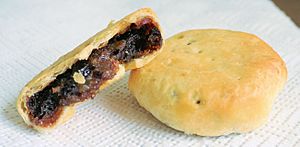
Greater Manchester has several local food specialities. Savoury dishes include black pudding, often linked to Bury, and pasty barm from Bolton. Rag pudding, a suet pastry filled with steak and onion, comes from Oldham. The Manchester egg was introduced in 2010.
Sweet treats include Eccles cake, a flaky pastry filled with currants from Eccles. The Manchester tart is a baked tart with raspberry jam, custard, and coconut. Uncle Joe's Mint Balls are traditional mints made in Wigan since 1898. Soft drinks like Vimto and Tizer were invented in Manchester. Boddingtons is a famous beer from Manchester.
The Greater Manchester Campaign for Real Ale supports local breweries and pubs. The Nursery in Heaton Norris and The Baum in Rochdale have won national awards. The Manchester Food and Drink Festival is a big event held in Manchester city centre. Other local events include the World Pie Eating Championship in Wigan. As of 2020, Manchester has one Michelin Star restaurant, Mana.
Galleries, Museums, and Exhibitions
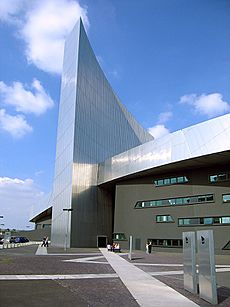
The Greater Manchester Museums Group (GMMG) connects eight of the ten museum services in the area. These include Gallery Oldham, Salford Museum and Art Gallery, and Bolton Museum. The Lowry at Salford Quays shows works by L. S. Lowry and other exhibitions. Manchester Art Gallery is known for its Pre-Raphaelite art.
Museums in Greater Manchester show the county's industrial and social history. The Hat Works in Stockport is the UK's only museum about the hat-making industry. The Museum of Science and Industry in Manchester shows how science and industry grew, especially in Manchester. Urbis is now the National Football Museum. The Stockport Air Raid Shelters show what life was like in World War II air raid shelters. The Imperial War Museum North in Trafford Park is one of five Imperial War Museums. The Museum of Transport in Manchester has a large collection of vehicles. The People's History Museum tells the story of working people in Britain. The Pankhurst Museum is in the former home of Emmeline Pankhurst, a famous feminist. Football clubs like Manchester United and Manchester City also have their own museums. Wigan Pier will reopen as a visitor attraction in 2023.
Media, Film, and Television
The Greater Manchester Film Festival started in 2012. It celebrates the region's strengths in film and TV. MediaCityUK in Salford Quays is a large media development. It is home to major media companies like ITV Granada and the BBC. One of Greater Manchester's most famous TV shows is Coronation Street. It is a soap opera set in a fictional part of Greater Manchester. It started in 1960 and is the world's longest-running TV soap opera. It is now filmed at MediaCityUK.
The area has several radio stations, including BBC Radio Manchester and Hits Radio Manchester. There are also local community radio stations for different towns.
The Manchester Evening News is a daily newspaper covering Greater Manchester. It is the most popular newspaper in the region. It was first published in 1868. MEN Media also publishes other local papers like the Oldham Advertiser and the Rochdale Observer.
Music, Theatre, and Performing Arts
Greater Manchester has many theatres, more than any other area outside London. The Royal Exchange Theatre is a famous theatre in the round. The Lowry at Salford Quays is Greater Manchester's most visited tourist attraction. It has two theatres. The Opera House and The Palace host touring shows and musicals. The Oldham Playhouse has helped start the careers of famous actors like Stan Laurel and Charlie Chaplin.
Greater Manchester has four professional orchestras, all based in Manchester. The Hallé is the UK's oldest symphony orchestra. The BBC Philharmonic is based in MediaCityUK. The Manchester Camerata and the Northern Chamber Orchestra are smaller groups. The main classical music venue is the Bridgewater Hall in Manchester. Manchester is also a centre for music education, with the Royal Northern College of Music.
The Manchester Arena can hold over 21,000 people. It is the largest indoor arena in the UK. It has been voted "International Venue of the Year." The new 23,500-seat Co-op Live arena is being built and will open in 2023. Sports grounds also host large music events. Factory International is a new cultural space that opened in 2023. It is named after Factory Records, a famous Manchester record label. This label was important for the "Madchester" music scene in the late 1980s. Greater Manchester is still known for its guitar and dance music.
Places to Visit in Greater Manchester
| Key | |
| Owned by the National Trust | |
| Owned by English Heritage | |
| Owned by the Forestry Commission | |
| A Country Park | |
| An Accessible open space | |
| Museum (free) | |
| Museum (charges entry fee) | |
| Heritage railway | |
| Historic House | |
|
|
See also
 In Spanish: Gran Mánchester para niños
In Spanish: Gran Mánchester para niños


